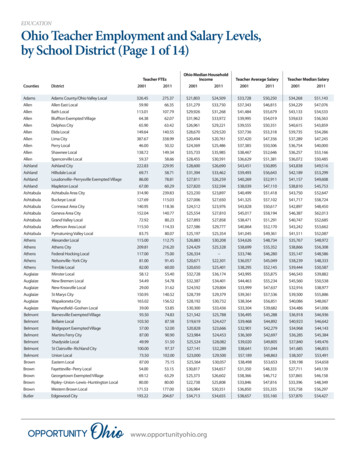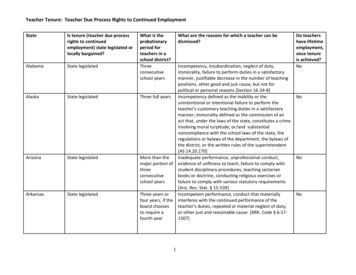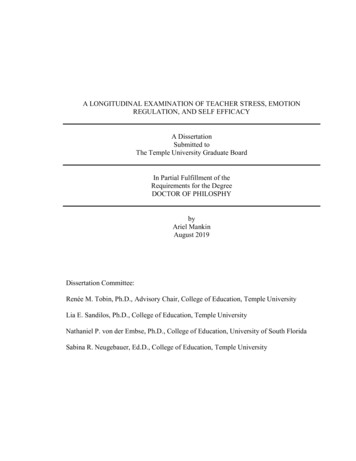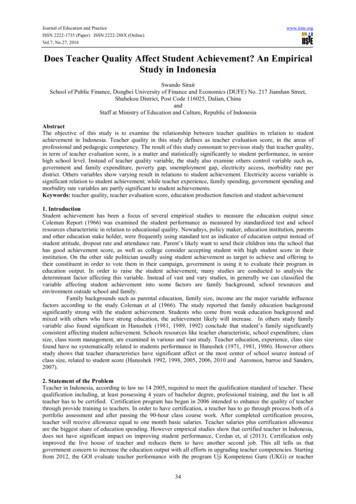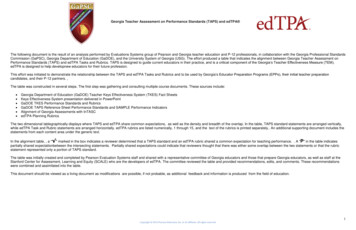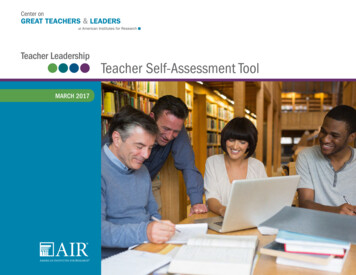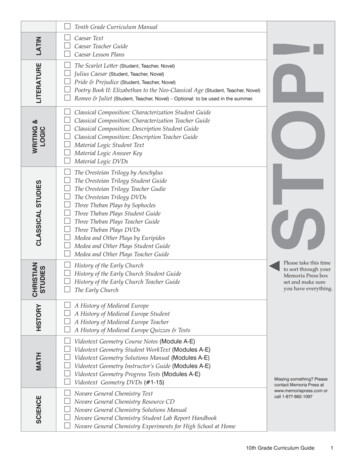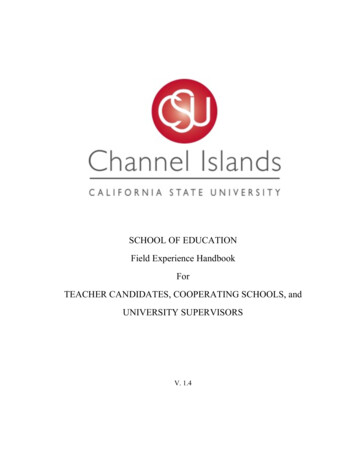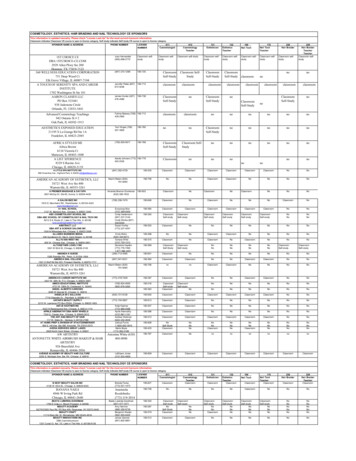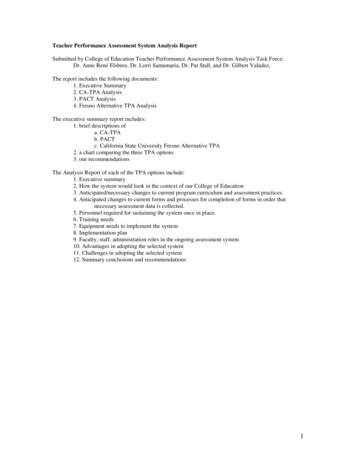
Transcription
Teacher Performance Assessment System Analysis ReportSubmitted by College of Education Teacher Performance Assessment System Analysis Task Force:Dr. Anne René Elsbree, Dr. Lorri Santamaria, Dr. Pat Stall, and Dr. Gilbert Valadez,The report includes the following documents:1. Executive Summary2. CA-TPA Analysis3. PACT Analysis4. Fresno Alternative TPA AnalysisThe executive summary report includes:1. brief descriptions ofa. CA-TPAb. PACTc. California State University Fresno Alternative TPA2. a chart comparing the three TPA options3. our recommendationsThe Analysis Report of each of the TPA options include:1. Executive summary2. How the system would look in the context of our College of Education3. Anticipated/necessary changes to current program curriculum and assessment practices.4. Anticipated changes to current forms and processes for completion of forms in order thatnecessary assessment data is collected.5. Personnel required for sustaining the system once in place.6. Training needs7. Equipment needs to implement the system8. Implementation plan9. Faculty, staff, administration roles in the ongoing assessment system10. Advantages in adopting the selected system11. Challenges in adopting the selected system12. Summary conclusions and recommendations1
Teacher Performance Assessment System Analysis Executive SummaryDate:To:From:Re:July 24, 2007The College of Education CommunityTeacher Performance Assessment System Analysis Task Force Dr. Anne René Elsbree, Dr. Lorri Santamaria, Dr. Pat Stall, and Dr. Gilbert Valadez, College ofEducationTeacher Performance Assessment System Analysis ReportIntroductionIn May 2007 Teacher Performance Assessment System Analysis Task Force was given the charge toprovide you a report with recommendations concerning the development and implementation of TeacherPerformance Assessment (TPA) for the College of Education, California State University San Marcos. Wewant it to be clear that our report is a recommendation; the final decision will be made by the COEcommunity. This report includes: descriptions of The CA-TPA, PACT, California State University FresnoAlternative TPA, a chart comparing the three TPA options, and our recommendations. We will providemore detailed information and time for discussion at the Fall Retreat and look forward to your decision.The Taskforce regularly met May through July to review each TPA option. In addition to our meetings andconversations we researched each of the models, interviewed faculty and pertinent program personnelinvolved with the models, and developed implementation plans for each. Our primary considerations were:- Support of teacher candidates in this high stakes assessment- Staff and faculty workload concerns- Alignment with our missionTPA Model DescriptionsEach of the models has similar tasks, e.g. planning, subject matter competency, assessment, and teachingperformance. The primary differences are in the implementation requirements. At best the completion ofthe TPAs helps the teacher candidates learn more about their teaching; however, the whole TPA packagecan be viewed by candidates as onerous and overwhelming in addition to the current teaching andcoursework responsibilities. The task force consistently considered how to support teacher candidates tofocus on their learning and view the Teaching Performance Assessment in that vein. The reflective natureof the tasks can be a positive influence in teacher development. Of the three models, only the CA-TPAprovided completion of the tasks over more than one semester to allow for more reflection time, coachingin coursework and remediation throughout the credential program. The PACT and Fresno Alternative TPAare implemented entirely in the student teaching experiences with little coursework support or time forguiding the reflection and coaching for success.CA-TPAThe California Teacher Performance Assessment (CA-TPA) builds in assessment for the teacher candidatesthroughout the credential program with support from coursework. CA-TPA is embedded in candidatecoursework (Tasks 1-3) and advanced student teaching (Task 4). It consists of 4 tasks:Task 1: Subject Specific Pedagogy TaskTask 2: Designing InstructionTask 3: Assessing LearningTask 4: Culminating Teaching ActivityTasks 1 and 2 and parts of Task 3 could be embedded in semester one coursework. Task 3 can becompleted in semester two coursework and Task 4 is completed during Advanced Student Teaching.Completing Tasks 1 and 2 in the 1st semester and Task 3 in the beginning of the 2 nd semester allows timefor coaching and remediation, when necessary, for resubmission.2
PACTPACT consists of embedded signature assignments as scaffolding and preparation for completion of theactual assessment, which is centered around one teaching event during advanced student teaching. It isquite similar to the INTASC portfolio, which is a based on the National Board Certified Teacher (NBCT)system and is modified for beginning teachers. It consists of artifacts, commentary (analysis), and reflectionbased on five tasks:- Context for Learning- Planning- Instruction- Assessment- Reflection.Fresno State Alternative TPA ModelCal State University Fresno has submitted an alternative TPA model, which incorporated existing tasks,specific to Fresno‘s credential program. Their TPA includes four key performance tasks:Task 1: Field ExperienceTask 2: Site VisitationTask 3: Holistic Proficiency ProjectTask 4: Teaching Sample Project.The tasks are implemented in a sequence during their student teaching experiences and are heavilydependent on supervisors and cooperating teachers coaching and assessing the candidates. It is currentlybeing reviewed by the commission and would have to be implemented as approved.TPA Model ComparisonThe following chart compares the three models with respect as to how each fits existing CSUSM College ofEducation Programs, our Mission, and our Vision. The pros and cons of each model are articulatedgraphically to provide a picture of the feasibility of each model from our perspective. Greater detail as tothe manner in which these models can be contextualized to the College of Education can be found in themore detailed reports available through our secure website, INSERT URL HERE. The reports contain therelevant timelines, assessment strategies, and training requirements.TPA Model Comparison ChartCriteriaFeasibilityCA-TPA Minimal impact onprogram. Easily embedded inexisting coursework.Alignment with Mission& Curriculum All four tasks explicitlyalign with our mission andvision statement by meetingthe needs of all students,specifically on Special Ed andELL. All CA TPEs are embeddedin the CA-TPA, except TPE12. CSUSM will need toassess TPEs 6d, 6e, 12, 14,15, and 16 separately. Study completed by thestate. All validity andreliability costs are assumedby the state.TPEsValidityStudent Workload Mildly increased workloaddue to Task 4. Task 1-3 areembedded in coursework.PACT- Maximum impact on fieldexperience component. Additiveapproach in existing fieldworkfor already overwhelmed teachercandidates.- Focus students in the teachingevent can be students whopresent an academic challenge,but it does require focus onSpecial Ed or ELL.Fresno Alternative TPA- Maximum impact on fieldexperience component. Additiveapproach in existing fieldwork foralready overwhelmed teachercandidates. Tasks 2 and 4 explicitly alignwith our mission and visionstatement by meeting the needs ofall students, specifically onSpecial Ed and ELL. All CA TPEs are embedded inthe PACT, except TPE 12.CSUSM will need to assessTPEs 6d, 6e, 12, 14, 15, and 16separately.- Study completed by PACTteam. Continued reliability andrevalidation costs are unknown. All CA TPEs are embedded inthe Fresno Alternative TPA,except TPE 12. CSUSM will needto assess TPEs 6d, 6e, 12, 14, 15,and 16 separately.- Study is under review by thestate. Reliability and validity arebased on local model in Fresno.There is no guarantee that theproposed TPA will be approved orallowed to use elsewhere.Reliability and revalidation costsare unknown.- Overwhelmingly increasedworkload since all 4 tasks arecompleted in fieldwork in additionto existing student teachingrequirements.- Overwhelmingly increasedworkload since all 4 tasks arecompleted in fieldwork inaddition to existing studentteaching requirements.3
Faculty WorkloadSupervision WorkloadStaff WorkloadProgram ArticulationData StorageTraining CostStudent Relevance- Moderately increasedworkload due to curriculummodifications, training andlearning curve. Mildly increased workloaddue to suggested support forTask 4.- Need a TPA coordinator andfulltime administrative staffto supervise implementation.This is a separate positionfrom AssessmentCoordinator. Increase programarticulation amongst andacross programs to supportstudent tasks.Tasks are addressed explicitlyin coursework. Developed and in PlaceElectronic storage viaTaskstream State supported Embedded in coursework- Student Teaching SeminarsAdditional Support forto support Task 4Student Teaching indicates Positive Impact- indicates Negative Impact Mildly increased workloadsince majority of the workloadfalls on supervision. Mildly increased workload sincemajority of the workload falls onsupervision.- Overwhelmingly increasedworkload since all tasks takeplace in field work.- Need a TPA coordinator andfulltime administrative staff tosupervise implementation.This is a separate position fromAssessment Coordinator.- Overwhelmingly increasedworkload since all tasks take placein field work.- Need a TPA coordinator andfulltime administrative staff tosupervise implementation.This is a separate position fromAssessment Coordinator.- Formative pieces necessary forpreparation of PACT shouldinclude faculty coordination, butit may not occur because thetasks are isolated in fieldworkand separate from coursework.- Hard copy notebook storage ordevelop an electronic portfolioin Filemaker Pro- Unknown- Isolated in AdvancedFieldwork- Student Teaching Seminars tosupport all 4 tasks- Formative pieces necessary forpreparation of PACT shouldinclude faculty coordination, but itmay not occur because the tasksare isolated in fieldwork andseparate from coursework. Developed and in PlaceElectronic storage via Taskstream- Unknown- Isolated in Fieldwork- Student Teaching Seminars tosupport all 4 tasksRecommendations of the Task ForceAfter consideration of these three models, the task force recommends that the CA-TPA program be pilotedwith one to two cohorts in the 07-08 academic year. Throughout the pilot year, regular reports and issueswill be brought to the community (during governance or some other venue) for continued conversation andbuilding of knowledge. Piloting the program for a year should provide the College of Education moreinsight into the logistical aspects of our assessment program.A number of factors were considered as justifications for this recommendation. Briefly, the factors weconsider are listed as follows:- Validity and Reliability of the CA-TPA has been determined by the state.- Training costs will be subsidized by the state as CA-TPA is their assessment program.- Implementation of the CA-TPA can be modified so teacher candidates do not experience a workoverload.- CA-TPA is a formative and summative assessment that is delivered over the entire credentialprogram allowing for structured opportunities for guided practice and completion of the TPA‘s.The task force believes both teacher candidates and faculty will benefit from formativeassessments prior to a final teaching performance assessment.- The TPA‘s are truly embedded throughout the credential program in this model, which will allowfaculty to provide support and guidance for our students over time.- The CA-TPA is the most faculty friendly in that we can use current program critical assessmenttasks and assessments. The reworking of course assignments, lesson planning, and reflectivewriting would be kept to minimum.- The CA-TPA will provide us with a unique opportunity to enhance our current programs inmeaningful ways through curriculum dialogue and course articulation.The CA-TPA is the most compatible with our mission statement.We look forward to engaging in a conversation with the COE Community at the Fall Retreat.4
CA-TPA (California Teacher Performance Assessment)1. Executive summarya. OverviewSenate Bill 2042 (Chapter 548, Statutes of 1998), signed by the governor in 1998,requires all multiple and single subject preliminary credential candidates attending fifthyear, intern, or blended teacher preparation programs in California to pass a TeachingPerformance Assessment (CA-TPA). This assessment is designed to give candidates theopportunity to develop, refine, and demonstrate their teaching knowledge, skills, andabilities during their teacher preparation program.The CA-TPA is imbedded in candidate coursework and is designed to be bothformative and summative in its usage. It is also linked to the California state-adoptedacademic content standards for students, the California Standards for the TeachingProfession, and the California Frameworks. The CA-TPA is part of a three-yearpreparation cycle of growth and development for teachers. All teacher candidates musttake and pass the CA-TPA in order to be recommended for a Preliminary TeachingCredential. After receiving the Preliminary Credential, and upon employment within aCalifornia classroom, candidates will participate in an approved induction programleading to a Professional Credential. The results of the CA-TPA will inform candidates‘Individual Induction Plan (IIP). Completing the CA-TPA will also help candidates tobegin using the California Formative Assessment and Support System (CFASST), oranother assessment system, during induction.b. Key ComponentsThe CA-CA-TPA consists of a series of four sequential performance tasks that togethermeasure the candidate‘s performance on California‘s Teaching PerformanceExpectations. These performance tasks are completed as part of the teacher preparationprogram.Subject Specific Pedagogy TaskThis task requires candidates to use information provided within the prompt aboutparticular students to identify appropriate subject-specific instruction and assessmentplans, and to adopt this information for these students. This task is based on writtenscenarios provided to the candidate that describe students in hypothetical classrooms.The following TPEs are measured in the Subject Specific Pedagogy task:TPE Description1Making subject matter comprehensible to students3Assessing student learning4, 6, 7 Engaging and supporting students in learning9Designing instruction and designing learning experiences for studentsDesigning InstructionThe Designing Instruction task requires the candidate to make appropriate connections5
between what the teacher knows about the students in the class to his/her instructionalplanning for those students. This written task contains a five-step set of prompts thatfocuses the candidate on first identifying and then applying the connections between thestudents' characteristics and learning needs and the teacher‘s instructional planning andadaptations for those specific students. The following TPEs are measured in theDesigning Instruction task:TPE Description1Making subject matter comprehensible to students4, 6, 7 Engaging and supporting students in learning8, 9Designing instruction and designing learning experiences for students13Developing as a professional educatorAssessing LearningThe Assessing Learning task requires candidates to demonstrate their ability to designstandards-based, appropriate student assessment activities in the context of a small groupof students using a specific standards-based lesson of the candidate‘s choice. In addition,candidates demonstrate their ability to conduct assessment activities appropriately toassess student learning and to diagnose student instructional needs based on the results ofthe assessment(s). The following TPEs are measured in the Assessing Learning task:TPE Description3 Assessing student learning6, 7 Engaging and supporting students in learning8, 9 Designing instruction and designing learning experiences for students13Developing as a professional educatorCulminating Teaching ActivityThe Culminating Teaching task is the culminating activity of the set of three CA-TPAtasks. In this task, the candidate designs a standards-based lesson for a class of studentsand teaches that lesson to actual K-12 students within the classroom setting, whilemaking appropriate use of class time and instructional resources, meeting the differingneeds of individual students within the class, managing instruction and interactions withand between students, and assessing student learning. Following the lesson, the candidatedemonstrates the ability to analyze the strengths and weaknesses of the lesson. To ensureequity to all candidates in the scoring of the Culminating Teaching task, a videotape ofthe lesson is collected and reviewed as evidence during the scoring process. All TPEsexcept for TPE 12 (Professional, Legal and Ethical Obligations) are measured in theCulminating Teaching task:TPE1DescriptionMaking subject matter comprehensible to students6
2, 3Assessing student learning4, 5, 6, 7 Engaging and supporting students in learning8, 9Designing instruction and designing learning experiences for students10, 11Creating and maintaining effective environments for student learning13Developing as a professional educatorIn order to score the Tasks, each one has a specific scoring rubric that describes thecharacteristics of a candidate‘s performance relative to that task. Each rubric has fourscore levels, ranging from a low of 1 to a high of 4. Scorers (assessors) are trained andcalibrated to apply each rubric to candidate performance.2. How the system would look in the context of our College of EducationTPEs are embedded in Tasks 1-4. We could likely replace TPEs with CA-TPAson Taskstream. TPEs would then be assessed as they are embedded in CA-TPAsby corresponding course faculty.CA-TPA Tasks 1-4 could feasibly be managed on Taskstream without anyadditional costs to candidates. Faculty and assessors however, would need someTaskstream training and support. Also, candidates can work on Tasks, post Taskswhen ready for review/ scoring, and create ‗Exit Portfolios;‘ all while Instructorsand Assessors can formatively and formally access Candidate CA-TPAs readily.Taskstream also has a ‗place‘ where students can virtually house up to twominutes if their Task 4 videotaped culminating teaching experience (a possiblestorage solution, worthy of further discussion and investigation).Subject Specific Pedagogy TaskMS, ICP, ML, & SS- Adjust current Critical Assessment Task ( CAT) for 511 tobecome one of these tasks for week 4 of first semester. 511 Instructors would beresponsible for managing and formatively evaluating this work as a part of theircourse curriculum. 511 instructors are not required to be CA-TPA Assessorsofficially trained in the Task, but would be familiar with formal training and use thesame rubrics and scoring methods as Trained Assessors. It is furthermore suggestedthat instructors not score their own students‘ work when possible, but that of anotherinstructors‘ section to ensure reliability. The task would then be formally scored byCA-TPA Assessors trained in the Task after candidates‘ final submission toTaskstream on the designated submission date. This process would provide rich datato the CSUSM COE and the CCTC.Designing InstructionMS, ICP, ML, & SS- Adjust current CAT for 555 to become this task for week 6 offirst semester. 555 Instructors would be responsible for managing and formatively7
evaluating this work as a part of their course curriculum. Instructors are not requiredto be CA-TPA Assessors officially trained in the Task, but would be familiar withformal training and use the same rubrics and scoring methods as Trained Assessors.It is furthermore suggested that instructors not score their own students‘ work whenpossible, but that of another instructors‘ section to ensure reliability. The task wouldthen be formally scored by CA-TPA Assessors trained in the Task after candidates‘final submission final submission to Taskstream on the designated submission date.This process would provide rich data to the CSUSM COE and the CCTC.Assessing LearningMS, ICP, ML & SS- Adjust current CAT for 521 & 522 to become this task for thefirst semester, to be assessed on week 4 of the second semester. 521 Instructorswould be responsible for preparing candidates to assess learners. 522 Instructorswould be responsible for managing and formatively evaluating the implementation ofassessing learning as a part of their course curriculum. 521 & 522 Instructors are notrequired to be CA-TPA Assessors officially trained in the Task, but would be familiarwith formal training and use the same rubrics and scoring methods as TrainedAssessors. It is furthermore suggested that instructors not score their own students‘work when possible, but that of another instructors‘ section to ensure reliability. Thetask would then be formally scored by CA-TPA Assessors trained in the Task aftercandidates‘ final submission final submission to Taskstream on the designatedsubmission date. This process would provide rich data to the CSUSM COE and theCCTC.Tasks 1& 2 are strategically assigned during the 1st semester so that remediation ispossible if necessary during the second 8 weeks for Full-time credential programs.Task 3 is learned during the 1st eight weeks and implemented during the 2nd eightweeks for full-time programs. Part-time programs will spread tasks out depending onwhen courses are offered making remediation feasible.Time-lines below specify suggested course impact, responsibility, and follow-up forFull and Part-time credential programs. ICP time-lines will vary as may those ofstudents attaining Special Education teaching credentials.Suggested timeline and breakdown of responsibilities for Tasks 1-3:Full time ProgramsSemester 1Course Impactedand ActionWho Responsible/for WhatFollow-upWeek 4Task 1: SubjectSpecific PedagogyTask Replaces 511CAT511 Instructor facilitatesTask.Trained Assessors scoreCA-TPA in time forfeedback to students incase remediation isnecessary.Candidates post toInstructors use CA-TPARubrics to grade/ scoreby end of week 5.8
Taskstream by end ofweek 4.Week 6Weeks 3-8Task 2: DesigningInstruction Replaces555 CATCandidates post toTaskstream by end ofweek 6.Task 3: AssessingLearning planning andadaptations replace 521CATCandidates post workin progress toTaskstream by end ofweek 8.Semester 2Week 4Task 3: AssessingLearning Assessmentand analysis replace522 CATCandidates postcompleted work inTaskstream by end ofweek 4.End of week 5for Task 1.555 Instructor facilitatesTask.Instructors use CA-TPARubrics to grade/ scoreby end of week 7.521 Instructors preparecandidates for Task.Instructors use CA-TPARubrics to guide gradingprocess by end ofsemester.522 Instructors facilitateTask.Instructors use CA-TPARubrics to grade/ scoreby end of week 5.End of week 7for Task 2.Tasks 1 & 2need to bepassed by end of1st semester.Trained Assessors scoreCA-TPA in time forfeedback to students incase remediation isnecessary.End of week 4(2nd semester) forTask 3.Task 3 needs tobe passed byweek 8 of 2ndsemester.Part-Time ProgramsSemester 1Course Impactedand ActionWho Responsible/for WhatFollow-upWeek 7Task 1: SubjectSpecific PedagogyTask Replaces 511CAT511 Instructor facilitatesTask.Trained Assessors scoreCA-TPA in time forfeedback to students incase remediation isnecessary.Candidates post toTaskstream by end ofInstructors use CA-TPARubrics to grade/ scoreby end of week 8.9
week 7.End of week 8for Task 1.Task 2: DesigningInstruction Replaces555 CATWeek 10Candidates post toTaskstream by end ofweek 10.Semester 2Week 7Task 3: AssessingLearning Replaces 521CATCandidates post toTaskstream by end ofweek 7.555 Instructor facilitatesTask.Instructors use CA-TPARubrics to grade/ scoreby end of week 11.End of week 11for Task 2.2nd Semester; end ofweek 8 for Task 3521 Instructor facilitatesTask.Instructors use CA-TPARubrics to grade/ scoreby end of week 8.Culminating Teaching ActivityMS, ICP, ML & SS-There have been many discussions as to ways in which to thinkabout implementing this task, which includes a somewhat prescribed culminatingstudent teaching experience as well a videotaped record of that teaching experience.It is suggested that this activity be (a) introduced in 512 or any other content specificsecond (final) semester course in which candidates design standards-based lessons fora class of students (e.g., Science, Social Studies, Math methods) and (b) supportedduring advanced student teaching via three required seminars. The Task like otherswould be posted to Taskstream and scored by CA-TPA Assessors trained in the task.Seminar Leaders may be required to score the Task to provide an additional score forconsideration, providing additional data to CSUSM COE and the CCTC.Suggested timeline and breakdown of responsibilities for Task 4:TimelinendWeek 6, 2Semester (orlast semesterfor PTstudents)***Week 9ComponentTask ResponsibilityFollow-up Action512, 544, 545 orother content areacourseInstructor/ Faculty:Ensure all candidates designstandards-based lesson forclass of students (i.e., K-8; 912; special education).None.RequiredAdvancedStudent TeachingEnsure all candidates givenaccess to appropriatepermissions documents forvideotaping lesson of finalobservation.Seminar Leader using specified content,based on CA-TPA 4:Review appropriate use of1. Seminar Instructorforwards attendancerecords to CA-TPA10
(ST) Seminar 1*,**class time and instructionalresources (511 content).Review meeting differingneeds of individual studentswithin class (555, 511, & 512content).Week 10RequiredAdvanced STSeminar 2Videotaping proceduresintroduced.Seminar Leader using specified content,based on CA-TPA 4:Review managing instructionand interactions with andbetween students (511 & 512content).Review assessing studentlearning (521, 522, 555content).Week 12Week 13VideotapedCulminatingTeaching ActivityRequiredAdvanced STSeminar 3(Candidates areassessed)CA-TPAEvaluation2. Seminar Instructorrevisits themes in Req.Adv. ST Seminar.1. Seminar Instructorforwards attendancerecords to CA-TPACoordinator.2. Seminar Instructorcollects and forwardsvideotaping permissionsto CA-TPA Coordinator.Video taping equipment checkout procedures reviewed.3. Seminar Instructorprepares students asnecessary for RequiredObservation.Candidates teach lessonsdesigned in content area course(week 6, 2nd semester) to K-12students within classroomsetting.1. The Supervisor maymake observation notesand scores candidatepursuant to specificationsfor CA-TPA Task 4.It is suggested that candidatesbe observed by regular Adv.ST Supervisor or CooperatingTeacher during this time.Seminar Leader ensures:Candidates demonstrate abilityto analyze strengths andweaknesses of lesson taught bycompleting Task 4 onTaskstream (should take placein computer lab or otherclassroom).Candidates turn in videotapedrecord of lesson.Week 14Coordinator.CA-TPA Assessors:o Verify candidates have turned invideotaped record of lesson toensure equity to all candidates inthe scoring of the CulminatingTeaching task.1. Seminar Instructorforwards attendancerecords to CA-TPACoordinator.2. Seminar Instructorcollects videotapedrecord of lesson.3. Seminar Instructorforwards videotapedobservations to CA-TPACoordinator.1. Tasks scored by CATPA Assessors trained inthe task.Remediation totake place duringweeks 15, 16 or11
beyond.*Required Advanced ST Seminars will be organized, taught, and delegated toinstructors recruited by the CA-TPA Coordinator in close consultation with theField Experience Director.**Seminars would be part of the units in Advanced Student Teaching (MS EDMS572.***Timeline would be adjusted appropriately for SS and Part-time Candidates.Note: Other scenarios have been discussed and certainly could be considered. This isjust one.3. Anticipated/necessary changes to current program curriculum and assessmentpractices.TPE Taskstream assignment and completion would potentially be REPLACED bythe CA-TPA process.A cadre of scorers will need to be trained rather quickly:o At least 1 CA-TPA evaluator per Task, per Cohort needs to be identifiedand prepared in order to appropriately assess candidates.Community replacement of Critical Assessment Tasks (CATs) with CA-TPAtasks would likely not be difficult. The unit/lesson plan required in all courseswould adopt the CA-TPA design. It is based on a universal backward planningmodel similar to the one currently used. A curriculum modification team hasbeen suggested.o Existing CA-TPA rubrics could replace current rubrics for CATs.Community would coordinate 511, 512, 521, 522, & 555 coursework to integratespecific parts of the CA-TPA tasks/assignments.CA-TPA Tasks 1-3 are embedded in coursework.o Task 4 is embedded in Advanced student teaching supported by 3 requiredseminars.o Tasks are to be completed on Taskstream with appropriate artifacts andfeedback to support positive outcomes for students.Course Instructor candidate work evaluation, though aligned with TrainedAssessor rubrics, forms, and procedures are not ―official‖ scores.o However, training opportunities will be made available to instructors,faculty, administrators.When Trained Assessors review complete Candidate CA-TPA Tasks, they willassign official scores to student work.o Students needing remediation will be coached and provided opportunity topass the CA-TPA in a timely manner.o Final scores are reported.o Students who pass all 4 Tasks, are recommended for their teachingcredentials.12
Three Required Advanced ST Seminars are necessary to support students withTask 4. Seminars would be part of Advanced Student Teaching (MS EDMS 572).See timeline above for suggested implementati
Fresno State Alternative TPA Model Cal State University Fresno has submitted an alternative TPA model, which incorporated existing tasks, specific to Fresno's credential program. Their TPA includes four key performance tasks: Task 1: Field Experience Task 2: Site Visitation Task 3: Holistic Proficiency Project Task 4: Teaching Sample Project.
